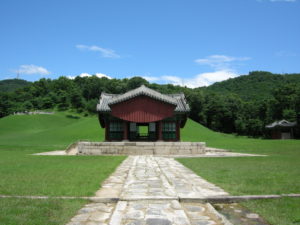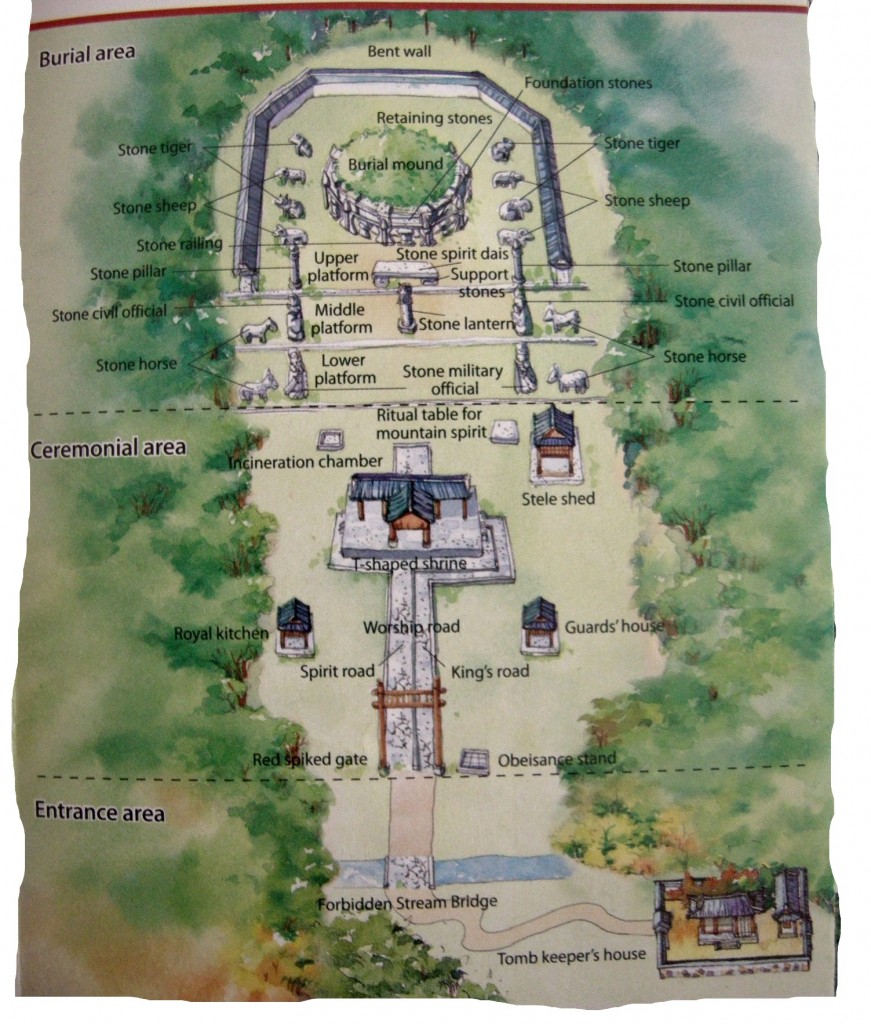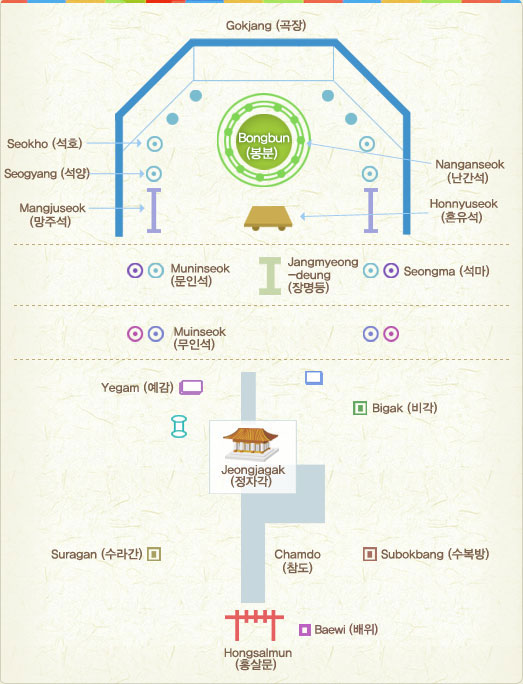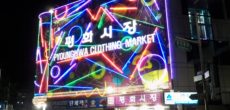
Typical Royal Tomb Site
There are 42 Royal Tombs of the Kings and Queens from the Joseon Dynasty (1392 until the end of the 20th century). All of the royal tombs have been well preserved over the years and most are located in or near Seoul except for 2 which are located in North Korea. In total there are 119 burials sites of the Joseon Royal Family which are broken up into 42 Neung, 13 Won and 64 Myo. Neung refers to the tomb of a King or Queen while won refers to a tomb for the Crown Prince, Crown Princess, King’s arents or other special people while myo refers to the less important royal members.
Here is a list of the 40 Royal Tombs in South Korea. There are 18 (excluding 2 in North Korea) main burial site locations which hold all the royal tombs. Scattered around locations in Korea, you may find more burial sites from the Joseon Period. Each of our pages below will give directions to each tomb site, information about the tombs located at this site with pictures and a short history of the person who is buried there.
In June, 2009 the 40 Royal tombs of the Joseon Dynasty were officially added to the UNESCO World Heritage Site list excluding 2 in North Korea.
Jeongneung Tomb – Tomb of Queen Sindeok, wife to King Taejo the founder of the Josen Dynasty.
Seoreung Royal Tomb – Location of 5 Royal Tombs, 3 Myo Tombs and 2 Won tombs.
- Gyeongneung Tomb: The royal tomb of King Deokjong and Queen Sohye.
- Changneung: The royal tomb of King Yejong and Queen Ansun his second wife.
- Myeongneung: The royal tomb of King Sukjong, Queen Inhyeon and Queen Inwon.
- Ingneung: The royal tomb of Queen Ingneung.
- Hongneung: The royal tomb of Queen Jeongseong.
- Also at Seooreung Tombs you can find the tombs of:
- Sugyeongwon
- Sunchangwon
- Daebinmyo
Seosamneung Royal Tomb site – Site of 3 Royal Tombs, 1 Myo tomb, 2 Won tombs.
- Huireung: This is the royal tomb of Queen Janggyeong.
- Hyoreung: This is the royal tomb of King Injong and Queen Inseong.
- Yereung: This is the royal tomb of King Cheoljong, the 25th monarch and Queen Cheorin.
- There are many other tombs at this site and in the surrounding area. Hyochangwon, Uiryeongwon, 45 tombs for royal concubines, tombs for princes and princesses and the placenta chambers. Some of them are closed to the public.
Uireung Tomb Site – The tomb is of King Gyeongjong and his second wife, Queen Seonui.
Donggureung Tomb Cluster: Donggureung is a cluster of 17 King and Queen tombs.
- Sureung: Sureung tomb holds the bodies of King Munjo (1809 – 1830) and Queen Sinjeong (1808 – 1890).
- Hyeolleung: Hyeolleung tombs is a twin tomb holding the bodies of King Munjong and Queen Hyeondeok.
- Mongneung: Mongneung tombs consists of the tombs of King Seonjo, Queen Ui-in and Queen Inmok.
- Geonwolleung: Geonwolleung tomb holds the body of King Taejo.
- Hwireung: Hwireung tomb holds the body of Queen Jangnyeol.
- Wolleung: Wolleung tomb holds the bodies of King Yeongjo and Queen Jeongsun in twin tombs.
- Gyeongneung: Gyeongneung is a unique triple tomb holding the bodies of King Heonjong, Queen Hyohyeon and Queen Hyojeong.
- Hyereung: Hyereung tomb holds the body of Queen Danui.
- Sungneung: Sungneung tomb is a joint twin tomb holding the bodies of King Hyeonjong and Queen Myeongseong.
Olleung Royal Tomb: This holds the body of Queen Dangyeong but is closed to the public.
Paju Samneung Royal tomb: This cluster is located in Paju, Gyeonggi-do and has 3 tombs.
Gimpo Jangneung Royal Tomb: King Wonjong and his wife, Queen Inheon.
- Yungneung: Yungneung tomb is the joint tomb of King Jangjo (the Crown Prince Sado, 1735-1762) and his wife, Hyegyeonggung.
- Geolleung: Geolleung tomb holds the bodies of King Jeongjo, 22nd King of the Joseon Dynasty and his wife Queen Hyoui.
- Seolleung Tomb: Seolleung Tomb holds the bodies of King Seongjong, the 9th King of the Joseon Dynasty and his second wife, Queen Jeonghyeon
- Jeongneung Tomb: Jeongneung is the royal tomb of the King Jungjong, the 11th King of the Joseon Dynasty.
Heonilleung Royal Tomb: Heonilleung Royal Tombs has 2 burial areas called Heolleung and Illeung.
- Heolleung Royal Tomb: Heolleung tomb holds the bodies of King Taejong, the 3rd king of the Joseon Dynasty and his wife, Queen Wongyeong.
- Illeung Royal Tomb: Illeung tomb holds the bodies of King Sunjo (1790-1834), the 23rd King of the Joseon Dynasty and his wife, Queen Sunwon.
Taegangneung Royal Tomb: Taegangneung tomb has two burial sites, Taereung and Gangneung.
- Taereung Royal Tomb: Taereung tomb holds the body of Queen Munjeong.
- Gangneung Royal Tomb: Gangneung tomb holds the bodies of King Myeongjong, the 13th King of the Joseon Dynasty and Queen Insun.
Sareung Royal Tomb: Sareung tomb holds the body of Queen Jeongsun. She was the wife of King Danjong, the 6th king of the Joseon Dynasty.
Hongyureung Royal Tomb: Hongyureung tomb site has two burial mounds called Hongneung and Yureung. This tomb site is important and unique.
- Hongneung Royal Tomb: Hongneung tomb holds the bodies of King (Emperor) Gojong, the 26th ruler of the Joseon Dynasty and his wife, Queen Myeongseong.
- Yureung Royal Tomb: Yureung tomb holds the bodies of Emperor Sunjong, the 27th ruler of the Joseon Dynasty and his first wife Empress Sunmyeonghyo and his second wife, Empress Sunjeonghyo.
Yeongneung – Nyeongneung Royal Tomb: There are two tomb burial sites, Yeongneung and Nyeongneung. This tomb site is very popular has it holds the body of King Sejong the Great.
- Yeongneung Royal Tomb: Yeongneung tomb is the joint tomb of King Sejong, the 4th King of the Joseon Dynasty and his wife, Queen Soheonwanghu.
- Nyeongneung Royal tomb: Nyeongneung tomb is a twin tomb where King Hyojong, 17th King of the Joseon Dynasty and Queen Inseonwanghu are buried.
Jangneung Royal Tomb: Jangneung Tomb is located in Gangwon-do and holds the body of King Danjong.
More about the Royal Tombs:
All of the Royal Tombs follow a similar layout but at the same time having their own unique touch.
 Photo taken from Cultural Heritage Administration Brochure.
Photo taken from Cultural Heritage Administration Brochure.
 1. Gokjang (곡장): Three sides of walls around the grave mound that protects the sacred ground.
1. Gokjang (곡장): Three sides of walls around the grave mound that protects the sacred ground.
2. Bongbun (봉분): The place where the deceased king or queen is buried. It is also called Neungchim (능침) or Neungsang (능상).
3. Byeongpungseok (병풍석): The stone support underneath and around the Bongbun, which protects it.
4. Nanganseok (난간석): The hedge-like stone outside Byeongpungseok, which protects the Bongbun.
5. Seokho (석호): Guardian deity made of stone in the shape of a tiger, which was erected to protect the Bongbun. The statue faces outwards.
6. Seogyang (석양): A sheep made of stone, which was erected to pray for the repose of the soul and fend off evil spirits from the earth.
7. Mangjuseok (망주석): A pair of stone pillars, which were erected on both sides of the front of the mound.
8. Honnyuseok (혼유석): The name means a stone that invites the soul to come out to play, this rectangular stone was erected in front of the mound.
9. Jangmyeongdeung (장명등): A lantern to comfort the soul and pray for its blessing.
10. Muninseok (문인석): Scholars made of stone erected on the left and right sides of the Jangmyeongdeung lantern.
11. Muinseok (무인석): Military officer made of stone, which was erected below Muninseok for guarding the king.
12. Seongma (석마): Horse made of stone.
13. Yegam (예감): This place was used for burning the written prayer following the memorial services. It is located behind Jeongjagak on the left side.
14. Bigak (비각): This building contains a stone monument, which has the name of the king and the queen engraved on the front and a list of the king’s accomplishments engraved on the back.
15. Jeongjagak (정자각): Memorial services are held in this building. The name of the building comes from its shape, which is the Chinese character Jeong (丁). The building should be entered by the right stairway (East) and exited by the left stairway (West).
16. Chamdo (참도): These stone covered paths lead from the Hongsalmun gate to the Jeongjagak building. The path to the left that is slightly higher is called Sindo (신도), or Path of the Gods; the path to the right that is slightly lower is called Eodo (어도), or the Path of the King. In accordance with Korean customs, visitors should walk only on the Eodo path.
17. Subokbang (수복방): This building is where the officer guarding the tomb lived.
18. Suragan (수라간): This building is where the foods for the memorial services were brought and prepared.
19. Baewi (배위): Next to the Hongsalmun gate are stones, which have been placed in a rectangle, this was where kings and memorial service officials knelt to honor and pray to the king buried in the tomb. It is also called Panwi (판위) or Eobaeseok (어배석).
20. Hongsalmun (홍살문): The gate has two red cylindrical pillars with no roof. The area past the gate is a sacred area, so visitors are asked to behave respectfully.
Information / picture taken from http://english.visitkorea.or.kr/enu/SI/SI_EN_3_6.jsp?cid=779495





